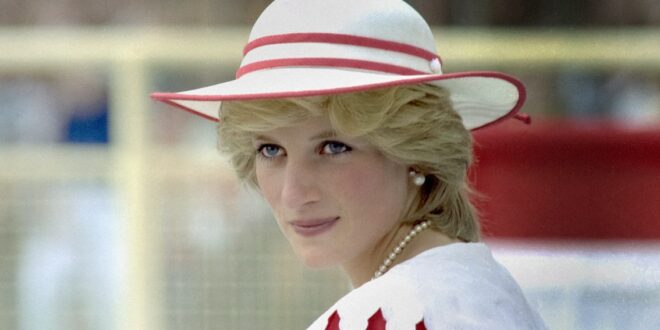Wendy Holden on writing The Princess and Diana’s little known story before becoming a Princess
The Princess, my new novel, is about Princess Diana. It is over a quarter of a century since she died and over four decades since that astounding wedding. The 1980s are now part of history; the Thatcher era and the Cold War are studied in schools. Diana herself is a historical figure, and so, I figured, deserved a historic novel.
Picking an angle was easy. I’ve always been interested in journeys to great fame; the portals through which people pass from obscurity to celebrity. In Diana’s case, the portal was when she stepped out of the carriage at St Paul’s. She was already well-known, of course, but this was when she went global.
But how had she got there? I knew a bit about her backstory; the kindergarten job, the famous see-through skirt. I knew she’d grown up at Althorp, the ancestral home in Northamptonshire, and had spent some giggly years in a Sloaney flat in Kensington. But how had all this connected and led to the moment at St Paul’s? Most importantly, what had she thought and felt as she moved through the years towards her amazing destiny? I would need to know this to write a convincing novel.
Most commentators and biographers agree her parents’ dreadful divorce overshadowed Diana’s youth. This, I discovered, was certainly part of the story. But not all. There were happy moments too.
During their earliest years at Park House, on the Sandringham Estate, Diana and her siblings had a den they called The Beatle Room, because of the cut-out images of the Fab Four peeling off the door. Here they would pile on the sofa and watch TV; a fire in the hearth adding to the cosy atmosphere. They had nicknames for each other; her sisters Sarah and Jane called Diana ‘Duch’, while Charles, her brother, called her ‘Brian’ after the slow-witted snail in the 1970s children’s TV programme, The Magic Roundabout. Sarah, a glamorous redhead who Diana hero-worshipped, did daring things like ride horses into the house and even up the stairs. One of their nannies liked to heap the car with picnic things and roar off with them to the nearby beach; once, also, she set up a Ouija board to entertain them. You can imagine what grist to the writer’s mill that incident was!
Occasionally, the two younger Spencers would pop over to Sandringham House, for a birthday party for one of the younger princes; Andrew or Edward. It was here, hiding behind a curtain with five-year-old Andrew during a game of Hide and Seek, the infant Diana first met her future husband. ‘Looks like a good party!’ remarked the 18-year-old Prince of Wales. But it wasn’t, Diana comments on one of the many documentaries I watched for research. Parties at Sandringham were all ‘ancient ladies-in-waiting standing about everywhere and endless re-runs of Chitty Chitty Bang Bang. I hated Chitty Chitty Bang Bang!”
Her father’s parties were much better, Viscount Althorp had an estate-wide reputation for brilliant children’s parties; he once hired a camel, called Bert, from Dudley Zoo for one of Diana’s parties. The children rode it around the herbaceous borders. He had installed an outdoor pool – one of the few in the whole country at the time – with revolving coloured lights at the bottom for swimming at night. At the annual Sandringham Show, Lord Althorp was famous for showing a film he had made of the Queen on her first tour of Australia – he had accompanied her as equerry. One frame showed her in jeans and people were so desperate to see it they packed out the tent during the multiple showings that were required.
As I absorbed all this, the Spencers started to grow in my writer’s mind as a colourful, upper-class family in the mould of the charismatic Radletts in Nancy Mitford’s The Pursuit Of Love.
But there was a downside to it all. Just as the jolly side was rather jollier than I had expected, the dark side was correspondingly much darker.
Diana’s parents’ divorce had been much more than a split. It had been a toxic battle of snobbery and betrayal. Diana’s own grandmother, Lady Fermoy, had given evidence in court against her own daughter, Diana’s mother Frances, claiming she was an unfit mother. The reason was less to do with Frances’ parenting than the fact that Lady Fermoy wanted the children to stay with the title, which meant staying with their father.
The roots of the marriage’s collapse also bear Lady Fermoy’s fingerprints. Decades before, she had practically forced Johnnie Spencer to marry her daughter, causing him to break off an engagement to someone else. When Frances failed to produce a live male baby to secure the Spencer line, only a succession of girls, she was subjected to humiliating Harley Street examinations and the certain knowledge she had failed.
I could hardly believe this had happened in the mid-twentieth century. Nor did it stop there. Lady Fermoy, having masterminded (if that was the word) one aristocratic marriage for her daughter, was eager to do the same for her granddaughter. Which, as it happened, dovetailed perfectly with the plans of her great friend, Queen Elizabeth the Queen Mother.
In the late 1970s, the royal family were desperate for Charles to marry. But to whom? He’d been out with every eligible woman in Europe, including Diana’s sister Sarah, who’d told the tabloids she had no interest in marrying him (one can imagine Lady Fermoy’s feelings when she read that!). Then, at the wedding of the middle Spencer sister, Jane, the eagle eye of the Queen Mother landed on the youngest Spencer girl. Diana was sixteen, and one of the bridesmaids. The eyes of the Queen Mother lit up. The Palace machine swung into action.
The degree to which the courtship and engagement of Charles and Diana was manipulated by the Palace is hard to believe. Many different people were involved, from courtiers to royal family members, and I traced every twist and turn, every motive and personality, filling in the gaps with my imagination. The route to the altar was like a social Grand National; Diana had to overcome a series of obstacles, from the polo match where Charles’ girlfriends traditionally made their debut, to the weekend at Balmoral which had proved the Waterloo of former candidates such as Georgiana Russell, who had found the fishing boring, and Sabrina Guinness, who had arrived in a press frenzy, infuriating Prince Philip.
In between, there was a week on the Royal Yacht at Cowes, where I imagined Diana drifting about the decks as Charles did his action man windsurfing thing. Determined researcher I was, I dug out all sorts of fascinating information about Britannia. Such as the silver candelabra that plug into an electric strip in the dining table, and the picnic trailer at Balmoral, intended to transport comestibles to far-flung estate bothies. It was designed by Prince Philip, who seemed to have a genius for solving the problems only very rich people have.
By the time all this was going on, Diana was living her happy Sloane life with her flatmates in Kensington. This was one of my favourite parts to write; four jolly girls all borrowing each other’s clothes, making spag bol suppers, answering the constantly-ringing telephone, banging on the bathroom door if someone was hogging it. They had a poster of Sting in their kitchen and a goldfish called Battersea in the sitting room. I imagined the coffee table piled with Daily Mails – Diana was addicted to it – and copies of TV Times – her favourite programme was Crossroads, which she liked to watch whilst eating a bowl of Harvest Crunch breakfast cereal.
I saw the girls as a supportive chorus, a bulwark of loyal friendship. They were surprised and dismayed when Diana announced, after the engagement, she was going to move into Buckingham Palace. It was five months before the wedding; what on earth was she going to do with herself? It seems Diana imagined her new family would instruct her in the ways of royalty, but this did not happen. Nothing happened. No-one took any notice at all.
A strange and unhappy episode began where the girl, still only 19, that the whole world was talking about, existed in a lonely bubble in the very heart of London. Sometime during this period she developed her bulimia. A couple of footmen took pity on her, bringing her burgers from the MacDonalds in nearby Victoria Street, but then she was told to stay away from the servants and so hung out with the equerries instead. In the equerries’ office she passed the time opening the parcels of wedding presents coming in from all over the world. One parcel, outgoing from Charles, was addressed to Camilla Parker Bowles, who Diana had imagined just a friend. She now realised she was actually rather more.
A few days before the wedding Diana had lunch with her sisters. She joked about not going through with it. “You’ve got no choice, Duch,” quipped Sarah. “Your face is on the tea towels.”
Diana went through with it, with results still playing out. For most people, seeing her emerge from her golden carriage, looked like the beginning of a story. For me, it felt like the end of one.
The Princess, by Wendy Holden, is published by Welbeck in August









Join the Discussion
Type out your comment here:
You must be logged in to post a comment.